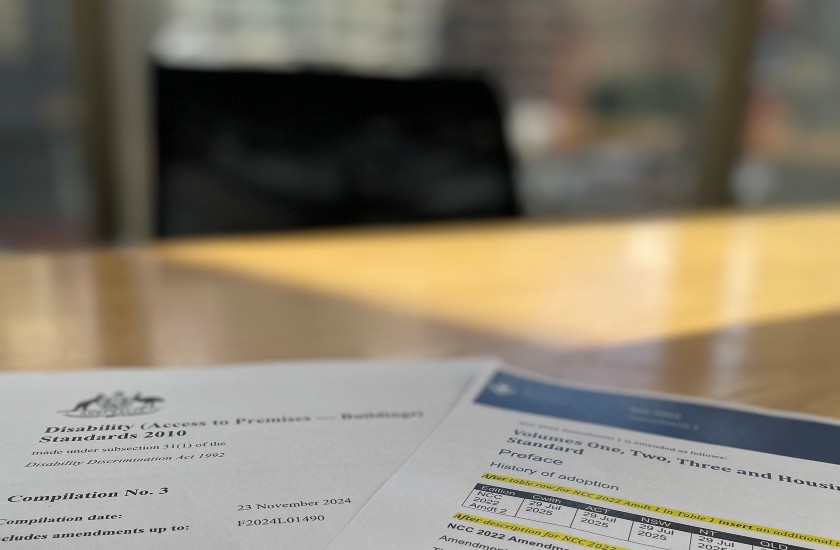
NCC 2022 Amendment 2: What changes under AS1428.1:2021 (SA from 29 July 2025)
South Australia now assesses new approvals against NCC 2022 Amendment 2, aligning the Code with the Premises Standards and updating references to AS 1428.1:2021. Here’s the practical summary for architects, builders and project managers.
Effective date: 29 July 2025
Author: TF Certifiers + Consultants
What’s changed (in one minute)
- National adoption: From 29 July 2025 across all jurisdictions, including South Australia.
- Purpose: Align the NCC with the Disability (Access to Premises—Buildings) Standards 2010.
- Reference update: AS 1428.1:2021 replaces the 2009 edition throughout relevant NCC clauses.
These changes apply nationally, but in South Australia they formally commence on 29 July 2025. With teams in both SA and Queensland, TF Certifiers is helping designers adapt early so projects aren’t caught out.
Why this matters
Most changes are clarifications and diagram updates, but they flow straight through to detail libraries, door and hardware schedules, and site checks. Even a few millimetres (e.g. kerb ramp widths, threshold ramps, or grabrail heights) can trigger redesigns or costly rework if overlooked.
Key updates to check in your documentation
- Continuous accessible paths & ramps
- Kerb ramps: 1600 mm clear (was 1500 mm).
- Curved ramps: inside radius ≤ 5 m + 1500 mm straight landings.
- Threshold ramps: 20 mm threshold measured after the 280 mm length.
- Grates & decking: max 150 mm clarified; added decking details.
Drawing checks: path widths, landing lengths, threshold call-outs, grate specs.
- Stairs & handrails
- Stair nosings: no multi-stripe patterns.
- Handrails: 25 mm detail change; ±10 mm landing tolerance; extensions measured excluding the return.
- Intermediate landings: clarified figures for compliant geometry.
Drawing checks: nosing schedule, handrail sections, landing notes.
- Doors & hardware
- Door identification: now explicitly includes pivot doors.
- Reveal depth: 300 mm reinstated/clarified.
- Power-operated doors: activation zone 0.5–1 m (was 1–2 m).
- Hardware measurement: dimensioning to the rose permitted.
Drawing checks: door schedules, hardware sets, clearances, activation zones.
- Sanitary facilities
- Backrests: clarified dims; TP holder ≤ 150 mm projection; cleaners’ tap zone clarified.
- Grabrail heights: 820 mm where backrest installed; clarified continuity.
- Ambulant WCs: Option 1 or Option 2 circulation (not both).
- Projection rule: pan projection requirement removed for ambulant WCs.
- Grabrails: lengths/heights adjusted.
Drawing checks: WC layouts, grabrail schedules, fixture encroachments.
- Washbasins & showers
- Basin height: 840 mm; operable parts must be dimensioned.
- Linear drains: permitted; showers can fall at 1:50 with linear drain.
- Shower fittings: head/rose size increased; taps ≤ 100 mm projection; restrictor/backflow if hose reaches WC or pan within 1500 mm.
- Circulation: no fittings below 2000 mm in the space; overlap with shower space now allowed.
Drawing checks: heights, falls, hose reach, device notes, overlap diagrams.
Practical takeaway
These updates look minor but they affect everyday documentation and site compliance. Missing them risks redesigns or rectification.
TF advantage: We pick these issues up at preliminary assessment stage, not after submission, so your project avoids redraws, delays or site fixes.
Final word
NCC 2022 Amendment 2 locks AS 1428.1:2021 into the Code from 29 July 2025. The detail shifts are small, but the risk of missed checks is big.
TF Certifiers + Consultants are already applying AS 1428.1:2021 in South Australia and Queensland. If you’d like us to review your detail libraries or upcoming submissions, get in touch — a 15-minute check now can save weeks later.
